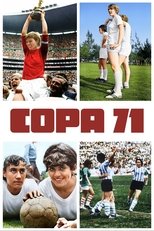A benefit of having Serena Williams as an executive on your movie is that your film gets a lot of attention, and in this case, a lot of movie reviews. The reviews for Copa 71 are all quite glowing, and I certainly agree this sports documentary is important for showing a piece of female football history that 99.9999% of us did not know.
And they give us the story in good fashion with a quick pace, great interviews, 70s music, and in 91 minutes – no longer than a match. So the film is definitely worth watching, but is the event significant? That’s for you to judge.
The History
In 1971, 6 womens teams gathered in Mexico for an international tournament not sanctioned by FIFA. At that time, FIFA only focussed on the mens game and had no structure in place to preside over upstart women playing organized football. However, FIFA was upset enough to warn the Mexican federation that no games could be played in stadiums under federation control.
The tournament organizers decided to play most games at Estadio Azteca, which was built and is owned by the media company Televisa (who own Club América), and half the group games at Estadio Jalisco in Guadalajara. Mexico had hosted WC 1970 the year before, so the organizers knew how to fill these large stadiums, sell merchandise, televise the games, and duplicate the excitement of the mens world cup. They promoted it as ii campeonato mundial futbol femenil – Womens World Football Championship, a follow-on to a 1970 tournament in Italy.

The mascot was Xóchitl, eponymous with a legendary female warrior and empress of the last of the Toltec empire, but reimagined with a Barbie figure, hotpants, and a soccer ball.
Six teams represented Argentina, Denmark, England, France, Italy, and Mexico. Co-Director Rachel Ramsey interviewed players from all the teams, now in their 60s and 70s. As you would expect from that time period (or from reading most of the reviews of womens soccer movies on this website), all of the women loved the game and had struggled to find a place to play or fans to watch. Italy may have been an exception, as they had a league, and the tournament organizers originated from Italy.
So coming to the games and being greeted and celebrated as world cup contenders was a shock to all the players. Fortunately, there was a lot of media coverage in Mexico, the games were all televised, and the players themselves kept scrapbooks and photos of their adventures. Also, many of the players are still alive and could be found. So the filmmakers put together a fairly complete story from all perspectives. It celebrates all the women as athletes who could have been intimidated by the immense stage they were on, but who rose to the challenge and played to win. For that time period, the amount of female football game footage is incredibly unusual and also quite satisfying.
Sadly, FIFA put a end to any further womens football at such a scale, until the inaugural officially sanctioned WWC 1991. Returning to England, coach Harry Batt was treated as the maverick he was for having taken a team to Mexico and was banned for life by the Womens FA. Any women playing for him in Mexico could have been equally banned. That, plus their losing record in the tournament, meant they returned home to anonymity. Ahead of WWC 2019, BBC published an extensive writeup on these Lost Lionesses, who were lost for almost 50 years.
In the film, football historian David Goldblatt fills in gaps for the audience. But for more coverage of an even earlier period in English womens football, check out the 2022 Metro article by Kirsten Robinson.
Players featured in the film
- Argentina = Elba Selva
- Denmark = Ann Stengård, Birte Kjems
- England = Trudy McCaffery, Janice Barton Emms, Carol Wilson (captain), Christine Lockwood
- France = Nicole Mangas
- Italy = Elena Schiavo, Daniela Sogliani, Maurizia Ciceri
- Mexico = Elvira Aracén, Alicia Vargas, Silvia Zaragoza, Martha Coronado
Note that “England” manager Harry Batt took a team of 14 players, only 2 of them over 20 years old, and the youngest was 13-14. Two players sustained broken bones in the first 2 games. And imagine going from a recreational pitch to the Azteca. That those young women withstood the heat, the altitude, and the size of the field is commendable. Their English looks were also quite the hit with Mexican fans. It’s sad that their countrymen did not appreciate the women’s effort.
In Conclusion
The story is interesting, and the soccer is nicely captured. It shows there was interest in womens sports outside of war time and the absence of men. It is an ambitious early tournament of female footballers, but to consider this the first womens world cup is going a bit far.
Personally, having watched so many soccer movies about female footballers, the theme of women fighting inequity is too commonplace to move me. Also for me, this film is not inspirational like the baseball drama A League of Their Own, where the real players are shown at the end of the film, still playing the sport they love. (Well of course it’s pretty hard to keep playing soccer after 60.) If anything, it’s a little sad to ponder the decades of personal freedom and opportunity that all women lost because of some stuffy old white men and bureaucrats.
But I’m an outlier, and for people who know little about soccer or sports or womens sports, this film could be an eye-opener. If that’s you, please give this film a watch.
7 Soccer Movie Mom Rating = 7
Resources:
- Released: 2023-09-07 (Toronto Film Fest)
- 1 hr 31 mins
- In English, Spanish, and Italian with English sub-titles
- I watched this on Kanopy
- IMDB
- WIKI
- Director: Rachel Ramsey , James Erskine
- Stars: Brandi Chastain
- Watch the UK Trailer

